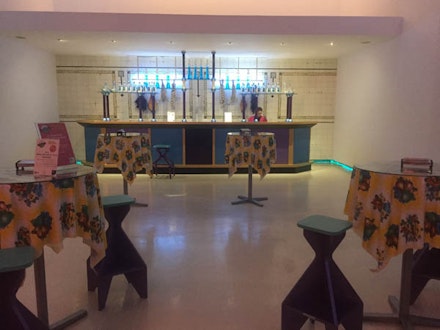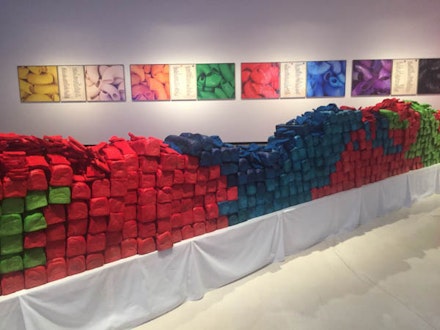ArtSeen
MIRALDA MADEINUSA
El Internacional Tapas Bar & Restaurant (1984–86), a social and artistic experiment made with the restauranteur Montse Guillén in New York’s Tribeca (Photo: Kathy Brew).
MIRALDA MADEINUSA
Azkuna ZentroaJune 7 – October 1, 2017
Bilbao (Spain)
From 1984 – 1986, El International Tapas Bar & Restaurant was the first restaurant to introduce tapas in the United States, but it was much more than a restaurant. The project, conceived by artist (Antoni) Miralda (he goes by his last name) and chef/restauranteur Montse Guillén, was a social/artistic experiment that embodied the cultural scene of downtown New York City in the ‘80s, and became an iconic hotspot for artists and political and cultural figures such as Andy Warhol, Jean-Michel Basquiat, Pina Bausch, Robert de Niro, David Byrne, Umberto Eco, Keith Haring, Michael Douglas, Grace Jones, Diane Keaton, John Kennedy, David Lynch, and Frank Zappa, among others.
The building in Tribeca was topped with a life size replica of the crown of the Statue of Liberty and became a culinary, artistic, and performative space, a prescient forerunner to current trends in social art practice and “food art.”
The fact is, Miralda was ahead of the curve. In the late 1960s he started Food Cultura, a series of social performances and events that explored the artistic, social, economic and political implications of food from a ritualistic and anthropological perspective. He and Montse Guillén continue this project to this day, extending the reach of their presentations into the public sphere in a celebratory spirit that transforms the universal act of eating into a creative realm beyond the insular art world by often including participants from each of the communities they visit.
MIRALDA MADEINUSA was initially presented at MACBA in Barcelona earlier in the year, but was recently on view at Azkuna Zentroa. Curated by Vicente Todolí (former Director of the Tate Modern), and designed in close collaboration with the artist and his archive, it is the first comprehensive exhibition presenting the fourteen projects that Miralda made in the U.S. from the mid ‘70s to the late ‘90s. Many of the most important installations were rebuilt for the exhibition, and included video documentation, drawings, sculptures, photos and more. Some of these works include: Breadline (1977), a multi-colored sculptural configuration of a line of bread, conjuring the bread lines from the Great Depression (and increasingly what we see today) of hungry people lining up to receive free food; Wheat and Steak (1981); Santa Comida/Holy Food (1984-85); and El Internacional Tapas Bar & Restaurant (1984-86).
Santa Comida/Holy Food—an installation that was first shown in 1984 at El Museo del Barrio in New York and subsequently in many other venues—explores Miralda’s fascination with Santeria, which he encountered in New York’s Spanish Harlem and in Miami. The elaborate installation includes a series of altars depicting both the Christian and Yoruba gods and foods connected with each saint—corn, beans, codfish, and much more. In the Bilbao retrospective, this part of the exhibition was presented off-site, at the Bilbao Museum of Reproductions, located in the San Francisco district, a vibrant, but poor neighborhood where many immigrants, artists, and students live.
Back at the main venue, Azkuna Zentroa, multiple spaces were recreated for the exhibition and the performative aspect of El Internacional was activated on a weekly basis throughout the run of the show. For example, visitors had the chance to taste a reinterpretation of a cocktail and pintxos (a Basque variation on the Spanish tapas) inspired by the menu and spirit from El Internacional in an installation environment that recreated the ambiance and look/feel of the original El Internacional. With nearly forty Michelin-starred restaurants, the Basque Country is one of the major culinary destinations in the world. Miralda collaborated with regional chefs to contribute unique pintxos to the weekly evening events. The effect of so much gustatory pleasure was utterly celebratory, creating the atmosphere of fun and generosity Miralda is known for, fully integrating cuisine with site-specific art.
Detail of El Internacional Tapas Bar & Restaurant featuring the signature blue margarita cocktail (Photo: Kathy Brew).
On one of the evenings, we drank the signature blue margaritas that El Internacional was famous for, along with tasty (and artful) treats. These were very exquisitely concocted items that are too difficult to describe. One of the tapas was like eating a delicious foamy cloud.
The following evening there was a special conference in the theater to further expand on the themes in the nearby Santa Comida installation. Here the discussion revolved around how the complex cultural and spiritual systems of black Atlantic religions—with their focus on the central role of sensuality, where rhythm, gesture, cuisine and clothing make up a daily texture—honor indigenous wisdom and evolved as “resistance tactics to colonialism.”
Following the conference, those of us in attendance ascended to the main atrium/lobby, where the delicious blue margarita cocktail was served, amidst a festive colorful setting as several different African musical/dance groups from the San Francisco district assembled in preparation for a procession through the streets of Bilbao, energetically dancing and playing music, carrying seven orishas (saints) as they meandered from the main cultural venue to the location of Santa Comida in San Francisco. Here a celebratory fanfare concluded the procession, which then dispersed into the final concept for the evening: 7 Offerings, 7 Places. Once again, this concluding aspect to the evening underscored Miralda’s emphasis on a spirit of community and revelry. Having concluded in the San Francisco district, viewers were given maps for an artistic bar crawl, almost like a culinary scavenger hunt, involving seven neighborhood venues that were offering participants other unique drink/pintxo combinations that ranged from garlic shrimp to grilled chicken skewers to olives and cheese and sausage, always combined with a tasty, crisp regional Spanish wine.
Although at this time it is not scheduled to come to the States, it would be great to have a show in Miami or New York given that much of the work was created when Miralda was living here. But for those interested in hearing from/and meeting the artist and learning more about El Internacional, Miralda will be at the Center for Architecture on November 3rd with an evening presentation and discussion of El Internacional (1984 – 1986): New York's Archaeological Sandwich, a book that was launched at PS1/MoMA in March of this year. A contemporary spin on El Internacional's famous blue margarita will be provided. To conclude with a Spanish toast: Salud!




